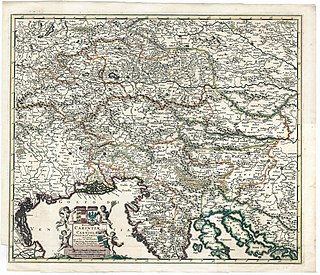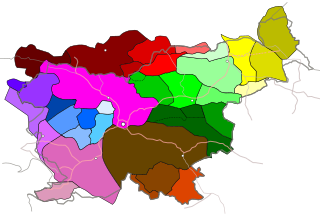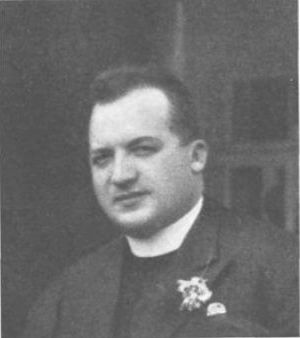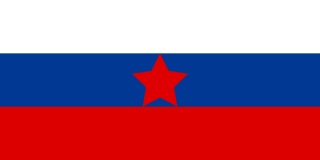
The history of Slovenia chronicles the period of the Slovenian territory from the 5th century BC to the present. In the Early Bronze Age, Proto-Illyrian tribes settled an area stretching from present-day Albania to the city of Trieste. The Slovenian territory was part of the Roman Empire, and it was devastated by the Migration Period's incursions during late Antiquity and the Early Middle Ages. The main route from the Pannonian plain to Italy ran through present-day Slovenia. Alpine Slavs, ancestors of modern-day Slovenians, settled the area in the late 6th Century AD. The Holy Roman Empire controlled the land for nearly 1,000 years, and between the mid-14th century and 1918 most of Slovenia was under Habsburg rule. In 1918, most Slovene territory became part of the Kingdom of Serbs, Croats, and Slovenes, and in 1929 the Drava Banovina was created within the Kingdom of Yugoslavia with its capital in Ljubljana, corresponding to Slovenian-majority territories within the state. The Socialist Republic of Slovenia was created in 1945 as part of federal Yugoslavia. Slovenia gained its independence from Yugoslavia in June 1991, and today it is a member of the European Union and NATO.

Venezuela is a country in South America. The Venezuelan people comprise a combination of heritages, primarily Native American and European. The historically present Native American, Spanish colonists, and African slaves have all contributed to varying degrees. Later, waves of European groups migrated to Venezuela in the 20th century, influencing many aspects of Venezuelan life, including its culture, language, food, and music though small in number.

The Slovenes, also known as Slovenians, are a South Slavic ethnic group native to Slovenia, and adjacent regions in Italy, Austria and Hungary. Slovenes share a common ancestry, culture, history and speak Slovene as their native language. They are closely related to other South Slavic ethnic groups, as well as more distantly to West Slavs.

Styria, also Slovenian Styria or Lower Styria, is a traditional region in northeastern Slovenia, comprising the southern third of the former Duchy of Styria. The population of Styria in its historical boundaries amounts to around 705,000 inhabitants, or 34.5% of the population of Slovenia. The largest city is Maribor.

Janko Prunk is a Slovenian historian of modern history. He has published articles and monographs on analytical politology, modern history, the genesis of modern political formations, and the history of social and political philosophy in Slovenia. He has also written on the history of political movements in Europe from the end of the 18th century until today, especially about Slovene Christian socialism and the history of Slovenian national questions.

Železniki is a small town in Slovenia. It is the seat of the Municipality of Železniki and it is the economic centre and the largest settlement in the Selca Valley. It includes the hamlets and neighborhoods of Jesenovec, Gorenji Konec, Ovčja Vas, Trnje, Racovnik, Škovine, Na Kresu, Češnjica, Log, and Tolar.
The Croatian diaspora consists of communities of ethnic Croats and/or Croatian citizens living outside Croatia. Estimates on its size are only approximate because of incomplete statistical records and naturalization, but (highest) estimates suggest that the Croatian diaspora numbers between a third and a half of the total number of Croats.

The history of the Jews in Slovenia and areas connected with it goes back to the times of Ancient Rome. In 2011, the small Slovenian Jewish community was estimated at 500 to 1,000 members, of whom around 130 are officially registered, most of whom live in the capital, Ljubljana.

Prekmurje Slovene, also known as the Prekmurje dialect, East Slovene, or Wendish, is a Slovene dialect belonging to a Pannonian dialect group of Slovene. It is used in private communication, liturgy, and publications by authors from Prekmurje. It is spoken in the Prekmurje region of Slovenia and by the Hungarian Slovenes in Vas County in western Hungary. It is closely related to other Slovene dialects in neighboring Slovene Styria, as well as to Kajkavian with which it retains a considerable degree of mutual intelligibility and forms a dialect continuum with other South Slavic languages.
Argentines of Slovene descent, also Slovene Argentines or Argentine Slovenes are the Slovenes residing in Argentina. According to Jernej Zupančič of the Slovenian Academy of Sciences and Arts, they number around 30,000.

European Venezuelans or White Venezuelans are Venezuelan citizens who self-identify in the national census as white, tracing their heritage to European ethnic groups. According to the official census report, although "white" literally involves external issues such as light skin, shape and color of hair and eyes, among others, the term "white" has been used in different ways in different historical periods and places, and so its precise definition is somewhat confusing.

Alojzij Kuhar was a Slovenian and Yugoslav politician, diplomat, historian and journalist. Together with Izidor Cankar and Franc Snoj, he was an important exponent of the liberal conservative fraction of the Slovene People's Party.

Young Slovenes were a Slovene national liberal political movement in the 1860s and 1870s, inspired and named after the Young Czechs in Bohemia and Moravia. They were opposed to the national conservative Old Slovenes. They entered a crisis in the 1880s, and disappeared from Slovene politics by the 1890s. They are considered the precursors of Liberalism in Slovenia.

Argentina–Slovenia relations refers to the bilateral relationship between Argentina and Slovenia. Both nations are members of the United Nations.

The Slovene Partisans, formally the National Liberation Army and Partisan Detachments of Slovenia, were part of Europe's most effective anti-Nazi resistance movement led by Yugoslav revolutionary communists during World War II, the Yugoslav Partisans. Since a quarter of Slovene ethnic territory and approximately 327,000 out of total population of 1.3 million Slovenes were subjected to forced Italianization since the end of the First World War, the objective of the movement was the establishment of the state of Slovenes that would include the majority of Slovenes within a socialist Yugoslav federation in the postwar period.

World War II in the Slovene Lands started in April 1941 and lasted until May 1945. The Slovene Lands were in a unique situation during World War II in Europe. In addition to being trisected, a fate which also befell Greece, Drava Banovina was the only region that experienced a further step—absorption and annexation into neighboring Nazi Germany, Fascist Italy, and Hungary. The Slovene-settled territory was divided largely between Nazi Germany and the Kingdom of Italy, with smaller territories occupied and annexed by Hungary and the Independent State of Croatia.
Greek Venezuelans are Venezuelan residents who are either fully or partially of Greek descent, or a Greece-born person who resides in Venezuela. They are mostly located in the north-center of Venezuela, concentrated in Caracas and Valencia.
Croatian Venezuelans are Venezuelans of full, partial, or predominantly Croat descent, or Croat-born people residing in Venezuela.
Slovene communities in South America refer to groups of people of Slovene ancestry living in various countries of South America. The first Slovenes arrived in South America in the late 19th and early 20th centuries, primarily from the Slovene Littoral region, and settled in countries such as Argentina, Brazil, Chile, Uruguay, and Venezuela. Slovenes arrived in South America for various reasons, including economic opportunities and political turmoil in Slovenia at the time. Many Slovenes found work in agriculture, industry, and trade in South America, and were able to build successful lives for themselves and their families.

Portuguese in Slovenia are citizens and residents of Slovenia who are of Portuguese descent.














